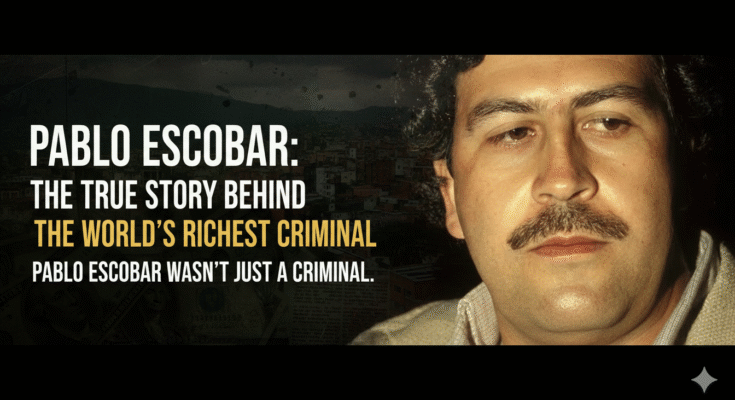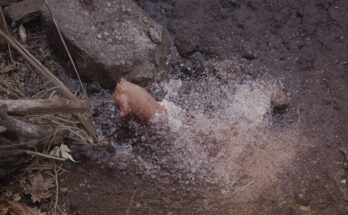Pablo Escobar wasn’t just a criminal; he was a force that reshaped Colombia. His story is one of staggering wealth and brutal violence. It’s a tale that will likely change how you see him.
Known as the “King of Cocaine,” Escobar was one of the richest criminals ever. But this narrative goes deeper. It explores the hidden truths and the terrible cost of his actions. Get ready for a perspective shift.
Our focus lands on a specific, horrific event: Avianca Flight 203. This tragedy was directly tied to Escobar’s ruthless agenda. Prepare for a heart-wrenching account of how it all went down.
The Setup: A Presidential Target on Avianca Flight 203
The Morning of November 27, 1989
It was a typical morning at El Dorado International Airport in Bogotá, Colombia. The year was 1989. The sun was just starting to climb, promising a normal day. Little did anyone know, tragedy was about to strike.
Avianca Flight 203 Takes Off
Avianca Flight 203, a Boeing 727, was ready for departure. It carried 101 passengers and six crew members, totaling 107 souls. Captain José and First Officer Fernando, experienced pilots, were at the controls. They prepared to fly everyone to Cali International Airport.
The passengers were a mix of people. There were foreigners and locals. Many were simply traveling for business or pleasure. Among them was a very important figure, presidential candidate César Gaviria Trujillo.
A Narrow Escape and a Fatal Deception
César Gaviria Trujillo arrived at the airport with his security team. Just as he was about to board, his guards stopped him. They cited security concerns, urging him not to board the flight. Trusting his team, Gaviria stepped away from the plane.
Meanwhile, Alberto Príeto, a member of the infamous Medellín Cartel, was also on board. He carried a seemingly innocent suitcase. This suitcase held a deadly secret. Príeto believed it contained a recording device. His mission was to activate it once the plane was in the air. He didn’t know he was carrying a bomb.
His accomplice, Santo, was also part of the plan. Santo boarded the flight with Príeto. They were seated in 15E and 15F, seats strategically located near the plane’s wings, which held fuel. But Santo had a different instruction: get on board, then get off. He left Príeto, who was unaware he was now alone with the deadly payload.
The Bombing: A Calculated Act of Terror
The Trigger: A “Recording Device” Activated
As Flight 203 climbed, it reached about 13,000 feet. Príeto, believing he was following instructions, reached into his pocket. He pulled out a small wireless button. He pressed it, thinking he was activating a recording device.
But this “device” was no recorder. It was a kilogram of dynamite. This was the bomb the cartel had planted. Príeto, completely deceived, had just triggered a devastating explosion. He was an unwitting instrument of terror.
Catastrophe at 13,000 Feet
At 7:16 AM, a massive explosion ripped through Avianca Flight 203. The force tore open the plane’s roof. The right wing was severely damaged. Fuel began to leak, and the aircraft erupted in flames. It became a falling fireball.
The plane lost control, plummeting towards the city of Soacha. It crashed into fields outside the city, causing another huge explosion. The magnificent Boeing 727 was reduced to wreckage. All 107 people on board perished in the horrific event.
The Motive: Extradition Treaty and Political Power
The Investigation: Unraveling the Truth
Authorities quickly labeled the incident an act of terrorism. It was unlike anything Colombia had seen before. No one initially understood how the bomb got on the plane. The investigation was massive. Boeing and the FBI joined forces.
They recovered the plane’s black box and CVR. These crucial pieces of evidence took about a year to analyze. The CVR revealed an intense sound. It even briefly stopped working due to the blast’s power. The data clearly showed an explosion, not mechanical failure.
The Cartel’s Demand: Canceling the US Extradition Treaty
The investigation eventually pointed to the Medellín Cartel. They claimed responsibility. Their goal was clear: to assassinate presidential candidate César Gaviria Trujillo. He was their main target.
But why the extreme measure? Escobar and his cartel were furious about an extradition treaty between Colombia and the US. This treaty meant they could be sent to America to face drug charges. Escobar, a major cocaine supplier to the US, was particularly vulnerable.
He had repeatedly asked the Colombian government to cancel the treaty. They refused. The bombing was his way of forcing their hand. He wanted to show them the deadly consequences of defying him. Tragically, 110 lives, including those on the ground near the crash site, were lost in this brutal act of political pressure.
Pablo Escobar’s Reign of Terror and Immense Wealth
The King of Cocaine: A Drug Empire
Escobar wasn’t just a criminal; he was the “King of Cocaine.” His drug empire spanned the globe. He supplied a massive amount of cocaine, especially to the United States. This illicit trade fueled his unimaginable fortune.
His reign was marked by extreme violence. It’s estimated that Escobar was responsible for the brutal murders of around 4,000 people. The Avianca bombing was just one instance of his terrifying power.
Unfathomable Wealth and Extravagance
Escobar’s wealth was legendary. One story tells of him burning $13 million just to stay warm during a cold night. This shows the sheer scale of his wealth. He had so much cash, he couldn’t put it all in banks.
He stored vast sums in warehouses. Rats would often destroy millions in cash. He needed 3-4 kilograms of rubber bands every month just to bundle his money. His assets also included seven private planes. He used these to transport cocaine. He also owned many islands. These housed his cocaine production facilities.
Building His Own Prison: La Catedral
In 1990, facing pressure, Escobar surrendered. But he didn’t go to a regular prison. He built his own: “La Catedral.” This wasn’t a typical jail. It was more like a five-star hotel. It had swimming pools and clubs.
Inside La Catedral, Escobar lived in luxury. He even ran a casino within its walls. He was essentially serving a sentence on his own terms. This showed his immense power and control.
The Hunt and Downfall of Pablo Escobar
The Breaking Point: Murder within La Catedral
In July 1992, things took a dark turn. Two of Escobar’s own men tried to betray him. Escobar had them murdered inside La Catedral. He then dumped their bodies outside the prison. This act crossed a line.
President Gaviria, who had narrowly escaped the Avianca bombing years earlier, had enough. He ordered a massive crackdown. The government was determined to bring Escobar to justice.
Operation Search Block: The Manhunt Begins
Authorities surrounded La Catedral. 400 elite soldiers were deployed. They were ready to storm the prison. But Escobar, ever the escape artist, vanished. He slipped away before they could capture him.
A special unit called “Search Block” was formed. It consisted of 600 of the best soldiers. Their sole mission was to find Escobar. They were authorized to bring him in, dead or alive. The hunt was on.
Retaliation and Escalation: Car Bombings
Escobar didn’t go down quietly. He retaliated against the government’s pursuit. He began using car bombs. These mobile bombs targeted politicians and police officers. Often, their families were caught in the blasts.
The conflict became deeply personal. The lines between law enforcement and criminals blurred. Escobar even offered bounties for killing police officers. The violence escalated dramatically.
The Final Days: A Life on the Run
Technology was now catching up. Authorities could intercept calls. They could track locations with greater accuracy. Escobar, once untouchable, was now constantly on the move.
For 16 months, he lived in hiding. He slept in storerooms and basements. He rented cheap rooms. Sometimes, he slept on the streets like a beggar. Only his two loyal bodyguards, Limón and El Chino, stayed with him.
False reports of his death circulated. Enemies spread rumors. This frustrated Escobar. He had immense wealth but couldn’t use it freely. His family, wife Victoria and children Juan Pablo and Manuela lived under police protection.
The Death of an Empire: The Battle of Los Olivos
The Fatal Phone Call
While on the run, Escobar had strict rules. Never talk on the phone for more than three minutes. Always change locations. He followed these religiously. This helped him evade capture for so long.
One day, he read a newspaper. It said his family had been granted asylum in Germany. This news brought him immense relief. He knew they would be safe. It must have made him incredibly emotional.
At 10:27 AM, he broke his rule. He picked up a landline. He dialed his family’s number. His son, Juan Pablo, answered. The call lasted 5 minutes and 47 seconds. It was the longest call he had made in months.
The Siege of Los Olivos
Unknown to Escobar, his call was being tracked. A secret bunker in Medellín housed advanced technology. This equipment intercepted his conversation. His location was traced to within 100 meters in the Los Olivos neighborhood.
Search Block teams mobilized. They quickly surrounded the area. They identified three possible houses. They knew their target was close. The net was tightening.
The Death of an Empire: The Battle of Los Olivos
The Siege of Los Olivos
The Search Block team arrived. They surrounded the area. They zeroed in on three houses. They knew Escobar was in one of them. The trap was set.
Suddenly, gunfire erupted. Escobar and his bodyguards opened fire. They were defending their position. The exchange was intense. Over 200 rounds were fired in minutes.
The Famous Photograph and Escobar’s End
The battle raged. Escobar tried to escape. He leaped across rooftops. A famous photograph captured this desperate moment. It showed him trying to flee.
But he was cornered. Search Block soldiers surrounded him. They had finally caught him. He lay on a rooftop, bleeding from his head and leg.
There are two accounts of his final moments. The official story says a sniper shot him. Others claim Escobar pulled out his own pistol. He pointed it at the soldiers, then turned it on himself. On December 2, 1993, at 3:15 PM, Pablo Escobar was dead.
Conclusion: The Enduring Legacy of Pablo Escobar
The news of Escobar’s death spread like wildfire. People in Medellín celebrated. Others mourned. For some, he was a monster. For others, he was a hero. His empire, built on cocaine, didn’t disappear.
New cartels rose to fill the void. Cocaine continued to flow out of Colombia. Escobar’s influence lingered. His story is a stark reminder of the dark side of power. It shows the devastating effects of greed and violence.
What do you think of Pablo Escobar? Was he a ruthless killer or a misunderstood figure? Share your thoughts in the comments below. You can also find more about him on my Instagram. Follow me there for more stories and to chat. What topic should I cover next? Let me know!



